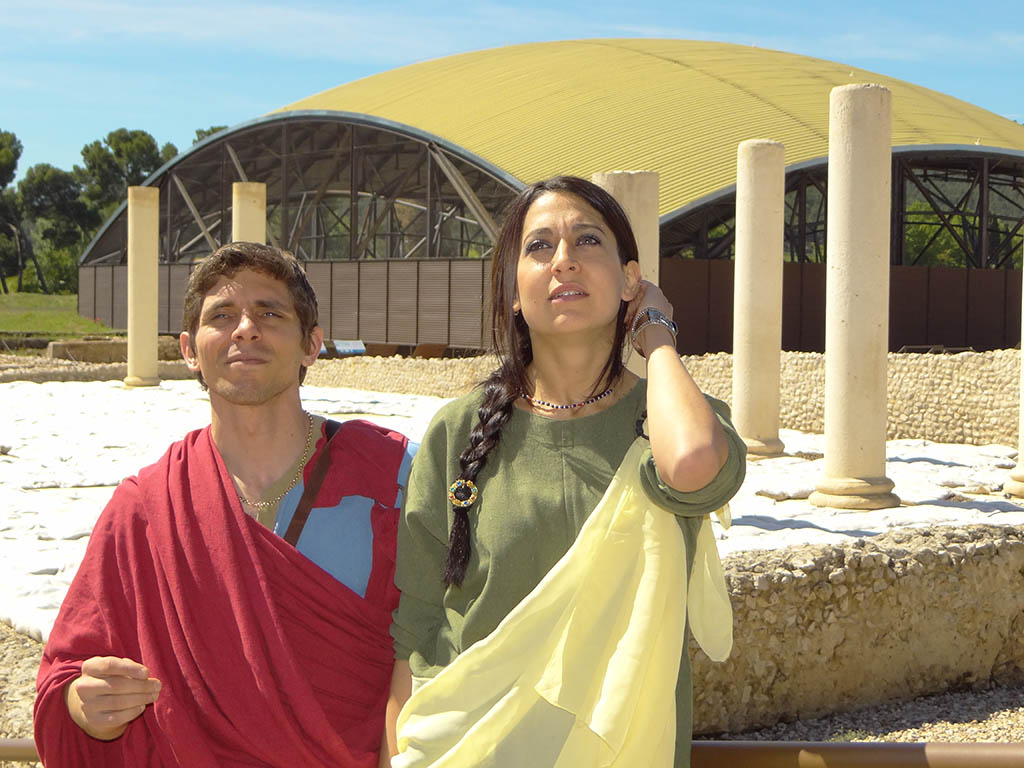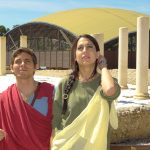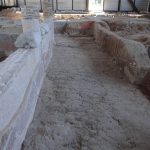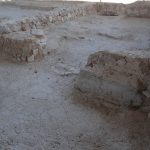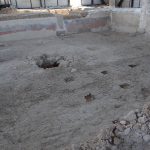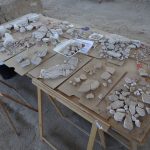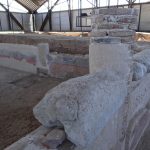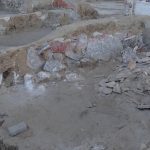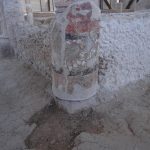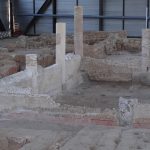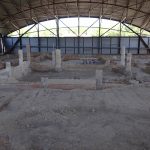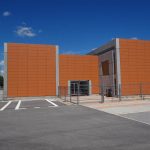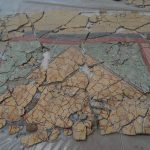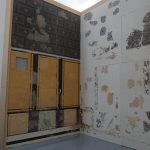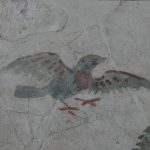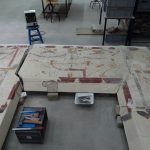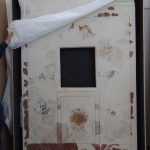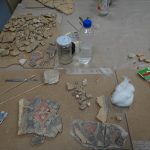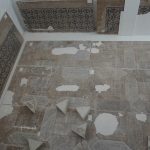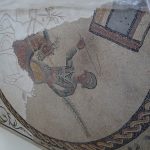Este texto también está disponible en español
The biggest and most enigmatic place of the archaeological site of Computum is a great metal structure. Built to protect the Casa de los Grifos [The Gryphon House], it is not possible to visit it. Let’s discover all its secrets.
Alcalá de Henares is worldwide known for being a World Heritage Site and Miguel de Cervantes birthplace. But no less important is the archaeological site of Complutum, the remains of the Roman Alcalá dating back from the first to the third century AC and a leading archaeological site for specialists.
This site shows the great importance of Complutum as a Roman city, a place that comprises all the elements of a great city such as its characteristic planning, the forum and its square, a basilica, thermal baths, a market, some administrative buildings from the government and houses of noble people from that period. The so-called Casa de Hippolytus can also be set as an example.
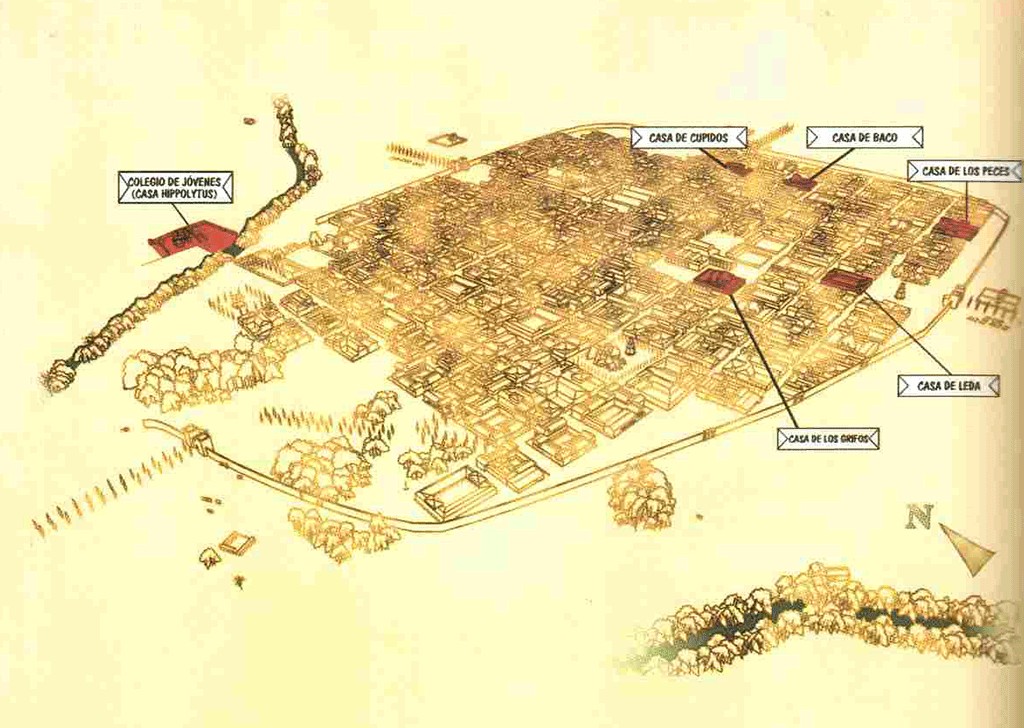 Complutum map with the main houses discovered by Archaeology.
Complutum map with the main houses discovered by Archaeology.
The archeological and maintenance technicians of the assets of Alcalá claim that the archaeological importance of the remains of Complutum are, in many aspects, at the top of all those of Western Europe, only preceded by the remains of the Italian city of Pompey.
Complutum suffered the sacking of Alcalá’s inhabitants themselves during centuries. The population used the old Roman city as a quarry to build the new city you can see nowadays. In fact, many of the stones and columns of famous areas—such as calle Mayor or the Archbishop’s Palace—come from Complutum.
Besides, and unfortunately, the quick and disorganized city planning of the sixties and seventies has been the result from the industrial boom in Alcalá. The uncontrolled digging and construction—on fields which, at that time, were known to host rests of an important Roman city—have produced the devastation of an important area of the Roman city.
However, a big part of the city has not been revealed yet. The excavations of Complutum started in 1985, when the law on Historical Heritage was approved, impelling investigation and making able the catalogue of rich Spanish rests. Thanks to the prospecting—and helped by aerial photograph and other techniques—, the total perimeter of the city has been delimited and the city planning has been documented. Five decumanus—main road from East to West—and one cardo —road facing North to South— have been preserved along with all the remaining buildings.
One of the plots holding the best treasures ever discovered is under a ceiling. In its interior works are being undertaken right now in order to recover one of the most important private houses—as architectonical document—of Western Europe—which has even been visited recently by the major of Rome himself.
The Gryphon House
Casa de los Grifos [The Gryphon House] belonged to a wealthy family of the Roman Complutum in the first century of the Christian Age and was inhabited for about 250 years. The works of digging and restoring started years ago, and in order to protect both, the remains and the archeologists’ works, a great roof—visible from any point of the site—was built up in April 2011. Among its treasures, this house counts on the best wall painting of a building preserved today in Spain. Sadly, it is not possible yet to walk by its spectacular central gallery as its inhabitants did.
We are referring to a 30 x 30 meter-floor house, 900 square meters in total, to which we should add a tavern—a room open to the outside and isolated from the rest of the house—moved forward over the fourth decumenus. Two magnificent porticos held by columns and surrounded by an arcade are also preserved in the enclosure.
In the inside of Casa de los Grifos, no less than seventeen ambiences have been found. The center consists in a peristyle—the most hidden part of a Roman house, a garden surrounded by a portico held by columns—enclosed by an arcade.
The name of Casa de los Grifos comes from the mythological animals decorating one of the most characteristic paintings of the house. An unfortunate fire and the following demolishment have been, however, a positive circumstance after all. Thousands of years later, that happening has allowed the archeologists to discover a great quantity of untouched and non-sacked treasures. There is not only an exceptional collection of wall painting but also plenty of different elements including organic remains—such as bones of dogs found in the well of the central garden of the house, probably thrown there after the great fire to avoid smelling and diseases. The paintings are currently being kept in City of Complutum Interpretation Center, and still closed for the public.
The excavation in this private house—that probably was abandoned at the end of the third century or at the beginning of the fourth century AC—started in 2003. Nowadays, more than seventy percent of its surface has already been discovered.
The continuous appearance of wall paintings in a very delicate state makes the works slower, so they have to be carefully extracted for its preservation.
The TEAR (Taller Escuela de Arqueología y Rehabilitación, or School-Workshop of Archeology and Restoring)—situated inside the same archeological enclosure in the old building of “Finca El Juncal” was in charge of restoring of both the wall paintings covering the stays of this noble house of the first century AC and the Roman forum of Complutum. However, the budget cut dictated by the Community of Madrid interrupted the important labor of this center that waits patiently better times to continue its teaching and archeological job.
The Roman city of Complutum was declared Bien de Interés Cultural [Festivity considered to be of cultural tourist interest] and categorized as Archeological Area in 1992. The investigation up to now have resulted in the discovering of important avenues, the foro—great part of which is visited by tourists since 2009—, a mausoleum, factories of bread and glass, and Casa de Hippolytus—opened to the public in 1999.
Image Gallery:
On Video:
Additional Information:
- Archaeological Site of Complutum
- Casa de Hippolytus
- Free guided performances through the Roman city of Complutum
- Address: Camino del Juncal, s/n 28001 Alcalá de Henares Madrid
- Phone: 918 771 750
Where is it:
Sigue disfrutando de Dream Alcalá:
- Telegram: Recibe nuestras noticias y contenido exclusivo (clic aquí).
- Newsletter: Recibe cada tarde un correo con nuestras últimas noticias (clic aquí).
- YouTube: Suscríbete para ver nuestros mejores vídeos (clic aquí).
 Sé tú el periodista: envíanos tus fotos o noticias a través de Telegram.
Sé tú el periodista: envíanos tus fotos o noticias a través de Telegram.

